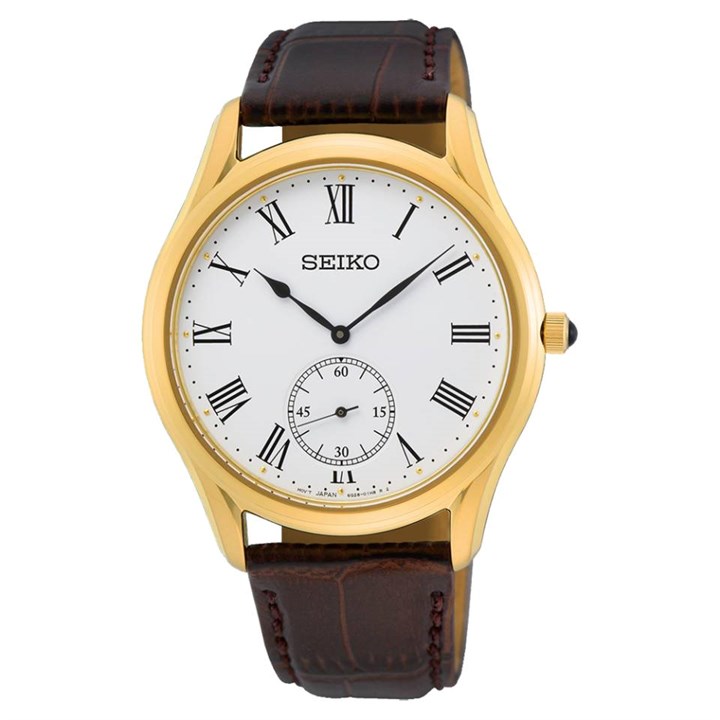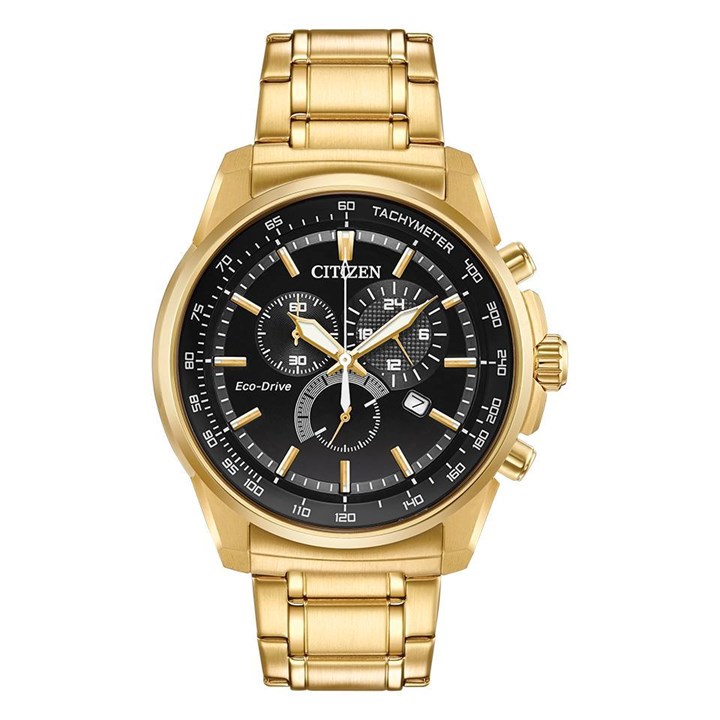Watch Movements Explained
The inner workings of a watch are known as the movement. There are various types of movements, each requiring different levels of care. We’ve put together this comprehensive guide to walk you through how each type works and how to properly care for your timepiece to keep it performing at its best.
Learn more about:
Quartz
Kinetic and Solar
Automatic
Mechanical
Eco-Drive
Quartz Watches

The Quartz Movement
The quartz movement - used in the vast majority of watches and clocks around the world today - was invented in 1927 by Warren Marrison, an engineer at Bell Laboratories in New Jersey. It’s based on a remarkable scientific principle known as the piezoelectric effect: when certain crystals (including quartz) are squeezed or stretched, they produce an electric field.
In a quartz watch, this effect is reversed. A small electric current, supplied by a battery, is applied to the quartz crystal, causing it to vibrate at a precise frequency. Marrison discovered that by applying an alternating voltage to quartz crystals, they could vibrate anywhere between 33,000 and over 4 million times per second and, crucially, maintain that rate with exceptional stability.
Using this principle, Marrison built the first quartz clock, accurate to within one second every ten years, a tenfold improvement over the best electric clocks of the time. However, it took another 40 years to miniaturize the technology enough for wristwatches. On Christmas Day, 1969, Seiko released the world’s first quartz wristwatch, marking a revolution in timekeeping.
Modern quartz movements operate at a frequency of 32,768 vibrations per second (32,768 Hz). The quartz crystal is built directly into the watch’s electronic circuit. When powered by the battery, the crystal oscillates at this constant frequency, and the circuit divides that signal to move the watch hands or digital display precisely once per second.
Because this frequency is incredibly stable and unaffected by normal wear, quartz watches are remarkably accurate, often losing or gaining only a few seconds per year—far better than most mechanical watches.
Like all precision instruments, quartz watches benefit from regular servicing to maintain the performance of their mechanical components.
Why Choose a Quartz Watch?

1. Exceptional Accuracy
Quartz watches are among the most accurate timepieces available. Thanks to the consistent vibration of the quartz crystal, most models lose or gain only a few seconds per month.
2. Low Maintenance
With fewer moving parts than mechanical movements, quartz watches are highly reliable and require minimal upkeep. Aside from the occasional battery replacement and general servicing, they’re easy to care for.
3. Affordability
Quartz technology is efficient and cost-effective to produce, making these watches more affordable without sacrificing precision or style. This makes them an excellent choice for everyday wear or as an entry point into watch collecting.
4. Durability and Reliability
They perform consistently in various conditions, from office environments to outdoor adventures.
5. Convenience
Quartz watches start instantly, don’t need winding, and keep running accurately even when not worn for long periods - perfect for anyone who wants a dependable timepiece.
6. Wide Range of Styles
From classic dress watches to sporty chronographs, quartz movements are used across nearly all designs, offering a huge variety of choices at different price points.
Kinetic and Solar Movements
Today’s watch enthusiasts have more options than ever, with solar and kinetic movements offering innovative, eco-friendly alternatives to traditional quartz and mechanical designs. Both types use renewable energy sources to keep the watch running and rely on a rechargeable battery to store power.
In kinetic watches, energy is generated through the motion of your wrist, similar to automatic mechanical movements. Solar watches, on the other hand, feature a solar panel hidden behind the dial that converts natural or artificial light into electrical energy.
One of the biggest advantages of solar watches is their impressive power reserve - many can keep running for months without light exposure, with some models maintaining a full charge for up to six months even when stored away in a drawer.
Automatic Watches

Unlike quartz watches that run on batteries, automatic watches are powered by the motion of your wrist. With proper care and understanding, your timepiece will provide reliable performance.
How an Automatic Watch Works
An automatic watch contains a mechanical movement powered by a rotor - a semi-circular weight that spins as you move. This motion winds the mainspring, which stores energy to drive the hands and any other features such as date or day.
If worn daily for an adequate amount of time (typically, 8-10 hours of wear per day), your watch will remain wound and accurate. If left unworn, it may stop after a certain period - this period is known as the power reserve. Once stopped, recharging via movement and resetting the watch is required.
As your wrist movement keeps the rotor spinning, maintaining the power reserve, it's important to consider if an automatic watch is the most practical choice for you.
If you have your heart set on an automatic watch for their craftmanship and mechanical beauty but feel you are sedentary for the majority of the day, or do not wear your watch daily or you simply prefer to switch between multiple watches, a watch winder will be your best friend! A watch winder simulates the wrists movement, keeping your watch charged when not worn.
Power Reserve
Most automatic watches have a reserve of 35-80 hours, depending on the movement. If not worn, the watch will gradually stop - simply wind it manually (if this a feature of your watch), wear it to recharge or use a watch winder.
Maintenance and Care
Tips
Keep the watch clean and dry.
Avoid exposing it to strong magnets (speakers, phones, magnetic clasps).
Store it in a watch box or soft pouch when not in use.
Clean with a soft cloth - avoid soap or chemicals.
Servicing
Have your watch professionally serviced every 3-5 years - a full service includes cleaning, lubrication, and accuracy adjustment.
Water Resistance
Check your model’s rating (e.g., 30m, 50m, 100m, etc.) before engaging with water.
Do not operate the crown underwater.
Common Questions
Q: My automatic watch stopped - is it broken?
A: No. It's likely ran out of power. Wear it for a few hours to restart.
Q: How accurate should my automatic watch be?
A: Most automatic watches vary ±10 to ±30 seconds per day, depending on the movement and wear conditions.
Q: Can I leave my automatic watch on a winder all the time?
A: Yes, quality winders simulate wrist movement and prevent oils from settling. Choose a winder that matches your watch’s winding direction and speed.
Mechanical Watches
What Is a Mechanical Watch?
A mechanical watch is a timepiece that runs without a battery - it’s powered entirely by a mainspring, a tightly wound metal coil that stores energy. That energy is gradually released through a series of gears and a regulating mechanism to move the hands and keep accurate time.
There are two types of mechanical watch - manual-wind and automatic (explained above).
For manual-wind watches the wearer must wind the crown regularly (usually once a day), this winding tightens the mainspring, storing energy for the watch to run. When the spring unwinds, the watch stops, until you wind it again.
In short, all automatic watches are mechanical, but not all mechanical watches are automatic!
Eco-Drive Technology by Citizen

Citizen’s Eco-Drive is an innovative light-powered technology that works much like a solar movement. First introduced in 1976, it was the world’s first watch movement to run on any kind of light - natural, artificial, or even dim - without ever needing a battery replacement.
The secret lies in a solar cell hidden beneath the dial, which efficiently converts light into energy. Once fully charged, an Eco-Drive watch can run for up to six months, even in complete darkness.
Some advanced Eco-Drive models include energy-saving features, such as automatically stopping the hands to conserve power. When the watch is re-exposed to light, the hands quickly move to the correct time on their own. Other models feature a Light-Level Indicator on the dial, letting you easily check how much power your watch currently has.
You may also be looking for...
About F.Hinds | Careers | Contact Us | Why Buy from F.Hinds? | Returns & Exchanges | Delivery Charges | F.Hinds Price Promise | FAQs | Ethical Trading | Associations & Accreditations | Statutory Reporting & Legal | Love Hinds | Love Hinds Edit
